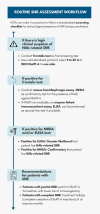Real-world Implications of Botulinum Neurotoxin A Immunoresistance for Consumers and Aesthetic Practitioners: Insights from ASCEND Multidisciplinary Panel
- PMID: 38903135
- PMCID: PMC11188869
- DOI: 10.1097/GOX.0000000000005892
Real-world Implications of Botulinum Neurotoxin A Immunoresistance for Consumers and Aesthetic Practitioners: Insights from ASCEND Multidisciplinary Panel
Abstract
Background: As long-term, regular aesthetic botulinum neurotoxin A (BoNT-A) use becomes more commonplace, it is vital to understand real-world risk factors and impact of BoNT-A immunoresistance. The first Aesthetic Council on Ethical Use of Neurotoxin Delivery panel discussed issues relating to BoNT-A immunoresistance from the health care professionals' (HCPs') perspective. Understanding the implications of BoNT-A immunoresistance from the aesthetic patient's viewpoint allows HCPs to better support patients throughout their aesthetic treatment journey.
Methods: A real-world consumer study surveyed 363 experienced aesthetic BoNT-A recipients across six Asia-Pacific territories. The survey mapped participants' BoNT-A aesthetic treatment journey and characterized awareness and attitudes relating to BoNT-A immunoresistance and treatment implications. At the second Aesthetic Council on Ethical use of Neurotoxin Delivery meeting, panelists discussed survey findings and developed consensus statements relating to the impact of BoNT-A immunoresistance on the aesthetic treatment journey.
Results: Aesthetic BoNT-A patients' depth of knowledge about BoNT-A immunoresistance remains low, and risk/benefit communications need to be more lay-friendly. The initial consultation is the most important touchpoint for HCPs to raise awareness of BoNT-A immunoresistance as a potential side effect considering increased risk with repeated high-dose treatments. HCPs should be cognizant of differences across BoNT-A formulations due to the presence of certain excipients and pharmacologically unnecessary components that can increase immunogenicity. Standardized screening for clinical signs of secondary nonresponse and a framework for diagnosing and managing immunoresistance-related secondary nonresponse were proposed.
Conclusion: These insights can help patients and HCPs make informed treatment decisions to achieve desired aesthetic outcomes while preserving future treatment options with BoNT-A.
Copyright © 2024 The Authors. Published by Wolters Kluwer Health, Inc. on behalf of The American Society of Plastic Surgeons.
Conflict of interest statement
Dr. Corduff serves as a clinical advisor and speaker for Merz Aesthetics. Dr. Park serves as a consultant of Merz Aesthetics. Dr. Ho served as an advisory board member and consultant for Merz Aesthetics. Prof. Martin serve(d) as an ad-hoc consultant and speaker for Merz. Dr. Tseng serve(d) as a speaker, trainer, and advisory board member for Merz Aesthetics, AbbVie, Bausch & Lomb, Cynosure, Galderma, and Solta. Dr. Vachiramon serves as a speaker for Merz Aesthetics, LG Chem, Leo Pharma, Beiersdorf, L’Oreal, and as an advisory board member for Merz Aesthetics, AbbVie, and L’Oreal. Dr. Yu serves as a key opinion leader for Merz Aesthetic Philippines. Dr. Dingley is/was a speaker and advisor for and has received funding from Merz Aesthetics, Galderma, and Allergan. All authors have received honoraria from Merz Aesthetics for their contributions during the ASCEND panel meeting and subsequent manuscript preparation. The other authors have no financial interest to declare.
Figures







References
-
- Jankovic J, Schwartz K. Response and immunoresistance to botulinum toxin injections. Neurology. 1995;45:1743–1746. - PubMed
LinkOut - more resources
Full Text Sources
Research Materials
